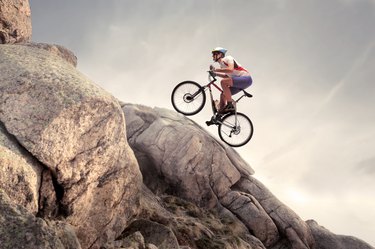
Pedaling uphill is far more difficult compared to cycling on a flat or downhill incline. This simple fact is the reason you burn more calories biking uphill. Your body works harder because you're pedaling against the forces of gravity. It's possible to estimate the effects of cycling uphill, but getting an exact figure is nearly impossible. Many factors influence your calorie-burn figure, including the steepness of the hill, duration of cycling, speed, gear you're in, wind resistance and other factors.
Flat vs. Incline
Video of the Day
Cycling on flat terrain is far easier than pedaling uphill, which is why you burn more calories with the former. For example, a 175-pound person biking on flat terrain at 15 mph burns about 353 calories per hour. The same person traveling at the same speed burns about 984 calories per hour going up a 3 percent incline. That's nearly three times more calories burned by traveling up a modest incline. Even if this cyclist were to slow down to about 10 mph while traveling uphill, she would still burn nearly 850 calories per hour.
Video of the Day
Calorie Burn Equation
An effective way to estimate the number of calories you burn cycling is to track your heart rate. The easiest way to do so is with a heart rate monitor watch, chest strap or both. Take your average heart rate, and enter it into one of the following equations to estimate calories burned. For men: ((-55.0969 + (0.6309 x HR) + (0.1988 x W) + (0.2017 x A))/4.184) x 60 x T. For women: ((-20.4022 + (0.4472 x HR) - (0.1263 x W) + (0.074 x A))/4.184) x 60 x T. "HR" stands for heart rate, "W" is weight in kilograms, "A" is your age in years, and "T" is the duration of the exercise in hours. Divide your weight in pounds by 2.2 to convert to kilograms.
Calorie Ups and Downs
Many controllable and uncontrollable factors affect your calorie-burning potential during your uphill climb. You can pedal faster and harder to burn more calories. The faster you travel, the more calories you'll burn. Factors like wind resistance, elevation, rocky or uneven terrain, and steepness of the grade are factors you can't control but can play a big role in how many calories you burn. Using the same 175-pound rider in the examples above, a 10-mph headwind would cause you to burn about 159 additional calories per hour, assuming you're traveling at about 10 mph.
Keep in Mind
Cycling uphill, as you now know, burns a substantial number of calories. It's not unusual to burn 1,000 or more calories per hour in some cases. So, always be sure to eat a carbohydrate-rich snack before heading up to the hills. Without adequate nutrition pre-ride, your body may start burning muscle tissue for the fuel it needs rather than carbohydrates or body fat – not an ideal situation. You can avoid this problem by eating something like a salad, peanut butter and jelly sandwich, or a bowl of oatmeal about 30 to 60 minutes before you begin your ride. And finally, never leave home for a bike ride without bringing along some water to stay hydrated.